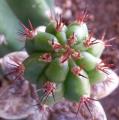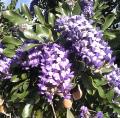
DMT-Nexus member
Posts: 187 Joined: 27-Aug-2013 Last visit: 18-Aug-2017
|
I was at the Desert Botanical Gardens the other day and surprisingly they only had 1 possible Trichocereus and it wasnt even on a labelled display. It was just in some pot off the side of the entrance. No one prolly bats an eye at this sexy ass Tricho. Im pretty sure my newb cacti ID'ing eyes see a Trichcereus Glaucus. What do you think ya'll? magic9 attached the following image(s):  20131231_122918.jpg (3,385kb) downloaded 397 time(s). 20131231_122924.jpg (3,493kb) downloaded 396 time(s). 20131231_122931.jpg (3,643kb) downloaded 391 time(s). 20131231_122942.jpg (3,160kb) downloaded 390 time(s).
|

DMT-Nexus member
Posts: 3207 Joined: 19-Jul-2011 Last visit: 02-Jan-2023
|
idk, but it deffo looks like a trich to me. buy and drink it  My wind instrument is the bong
CHANGA IN THE BONGA!
樹
|
DMT-Nexus member

Posts: 1175 Joined: 10-Jun-2010 Last visit: 27-Dec-2024
|
just because it has a blue frosting doesn't make it a t. glaucus
i'd call it a peruvianus
|

DMT-Nexus member
Posts: 908 Joined: 06-May-2012 Last visit: 07-Mar-2020
|
Yeah, looks like a t. peruvianus. 3... 2... 1... BLAST OFF!!!!FFO TSALB ...1 ...2 ...3 My grafting guide
|

DMT-Nexus member
Posts: 1453 Joined: 05-Apr-2009 Last visit: 02-Feb-2014 Location: hypospace
|
Some online present some bad IDs for T glacus, so here is the original species description translated into english, note the width and petal colors, and flattened spines in the description... Quote:
Trichocereus glaucus
First description was in:
Friedrich Ritter 1981
"Kakteen in Südamerika" Band 4: 1328, 1553
Page 1553
Fig. 444. Trichocereus glaucus.
RItter's 1981 description:
page 1328
Trichocereus glaucus Ritt. K.u.a.S., 1962, H. 11, S. 180
Body: shrubs from 1 to more than 2 meters tall and often several meters in diameter, appearance of columns is largely stepped on the lower situated branches but less stepped above [[Unclear: from "sprossend haupsächlich unten von liegenden Trieben, weniger oben sprossend"]]
Branches 5-8 cm thick, upright, later prostrate in the lower parts, new growth blue green, later more grey green.
Ribs 7-9, very broad & blunt, 7.5-13 mm high, 15-25 mm wide, notched, with furrow along breadth but not extending to the divided furrows of the rib.
Areoles are filled with grey felt [Knize’s have brown on new areoles], ½-¾ cm diameter, set 1-2 cm apart, with humps stretching downward into the notches. [Unclear: from "von den Höckern in die Kerben hinabreichend."]]
Spines in the new growth black to brown, then fading, straight [or erect or upright], stiff [or rigid],
Radial spines 7-10, on the side of arranged, the lower and lateral 8-15 mm long, robustly needle shaped, somewhat flattened, the upper are stronger and not as sharp as the Centralspines.
Centralspines 3-6, very widely spreading, awlshaped, 2-8 cm long, the lowest usually flattened, the strongest sometimes in the middle, but usually closer to the upper edge and almost in the position of a radial spine, 1.5 mm thick at base.
Blossoms borne close to the top of the column, 13-19 cm long, smell sweet, opening in evenings but remaining open in the morning (Notes are from 4 blossoms of different specimens of the Type.)
Ovary green, with green scales, narrowly triangular, 2-5 mm long sharp scales and large elevated scale bases, with strong black or brown black wooly hairs, the divider against the nectar chamber is 3-4 mm thick. This tube, 13-23 mm long, set 1-2 mm wide around the Style, is brownish, almost open, with nectar.
Floral tube is nearly funnelshaped, 40-65 mm long, above 2-3 cm wide [oben 2-3 cm weit], interior is pale greenish,
[[Unclear portion: Insertionen are absent on the uppermost 2-3 cm of the tubes up to a ring on the seam;
From "Insertionen fehlen auf den obersten 2-3 cm der Röhre bis auf einen Ring auf dem Saum"]]
Anthers pale brown, [[Unclear portion: “about from because of Kronblatter-height standing” from: "etwa bei halber Kronblatter-höhe stehend".]]
Style is pale green, above white or pale brownish, 10-11 cm long, with 14-18 mm on the 13-16 spreading pale yellow stigma lobes between the anthers or above them.
Petals 5-8 cm long, 1-2 cm wide, above trains tip or blunt with a Spitzchen, at which basis extends less than 1/3 the width, in 2/3 until ¾ height at that, the external petals are longer, narrower and more spatulate, above [[Unclear "zugespitzt"]]; internal petals are white or slightly pink, much shorter, of below from [[Unclear "zugespitzt"]], pink until almost bloodred, passing into the scales.
[[From: Kronblatter 5-8 cm lang, 1-2 cm breit, oben zugespitzt oder stumpf mit einem Spitzchen, an der Basis weniger als 1/3 breit, bei 2/3 bis ¾ Höhe am breitesten, die äusseren die längeren und schmaleren und mehr spatelförmig, oben zugespitzt; innere weiss oder gering rosa, die äussersten kürzer, von unten ab zugespitzt, rosa bis fast blutrot, in die Schuppen übergehend. ]]
Fruit grass green, ca 4 cm long, 3 cm thick, at both ending bluntly, half almost entirely covered like the ovary, flesh is white, mature fruit bursts above.
Seed ca 1.2 mm long, 1.0 mm wide, 0.6 mm thick, at the apical end [[Unclear: ventralwärts vorgewölbt]]; Testa black, somewhat shining, with dimples; hilium at the [[Unclear: abgestutzten]] basal end, oval, very large, blackish.
Type collected in the mountains at the lower course of the TAMBO-river, Depart. Arequipa.
Grows also in the region of IlO.
Related to Trichocereus chalaensis.
Ritter discovered in 1954. Designated the collection as FR 270. Fig. 1194.
Note the fairly large number of central spines as many as 6!, some of the petals are pink to red and the flowers are not as large as in peruvianoid types... the width of the branches is 5-8cm, that is 2-3 inches wide max, where peruvianoid types can be 4-6 inches or a bit wider. It is not a thick branched plant. You will note that many of the plants represented as T glaucus online are clearly not.
|

DMT-Nexus member
Posts: 69 Joined: 02-Mar-2013 Last visit: 16-Aug-2018 Location: zone 8
|
I have a seedling that looks like this one.. redish spines medium big areoles with 7 to 8 spines. Ill has its a real deal peruvianus. Possibly matucana.
|

DMT-Nexus member
 
Posts: 1288 Joined: 22-Feb-2014 Last visit: 16-Mar-2024
|
I was driving past a local nursery and had a feeling I needed to stop in and take a look. I found two that stood out to me. Is there any way that you guys can help with a possible ID? AcaciaConfusedYah attached the following image(s):  20140515_185738.jpg (205kb) downloaded 557 time(s).Sometimes it's good for a change. Other times it isn't.
|
DMT-Nexus member

Posts: 1175 Joined: 10-Jun-2010 Last visit: 27-Dec-2024
|
1 appears to be pc pachanoi
2 is not a trichocereus
|

DMT-Nexus member

Posts: 1843 Joined: 28-Jun-2012 Last visit: 20-Jul-2021
|
as dg said: #1 PC pachanoi #2 Pilosocereus of some sort, probably P. azureus or P. pachycladus + ---- + ---- + ---- + ---- + ---- + ---- + ---- + ---- DMT Nexus Research ---- + ---- + ---- + ---- + ---- + ---- + ---- + ---- +
|

DMT-Nexus member
 
Posts: 1288 Joined: 22-Feb-2014 Last visit: 16-Mar-2024
|
Thanks guys! The PCs are said to have a lower alkaloid content, if any, correct? Sometimes it's good for a change. Other times it isn't.
|

DMT-Nexus member
Posts: 908 Joined: 06-May-2012 Last visit: 07-Mar-2020
|
PC pachanoi pilocereus azureus 3... 2... 1... BLAST OFF!!!!FFO TSALB ...1 ...2 ...3 My grafting guide
|

enthusiast
Posts: 117 Joined: 11-Aug-2011 Last visit: 22-Jun-2017
|
hello, looking for an ID on these two cacti.  as above, so below
|
DMT-Nexus member

Posts: 1175 Joined: 10-Jun-2010 Last visit: 27-Dec-2024
|
agreed they are not trichocereus...
|

enthusiast
Posts: 117 Joined: 11-Aug-2011 Last visit: 22-Jun-2017
|
thank you gents, will keep looking. as above, so below
|

DMT-Nexus member
Posts: 202 Joined: 16-Dec-2011 Last visit: 28-Jun-2017 Location: Costa Blanca, Spain
|
McCoyBoy wrote:hello, looking for an ID on these two cacti.  The one on the left is not actually a cactus - it is Euphorbia pseudocactus. Life is a shit sandwich - the more bread you got, the less shit you eat.
|

Astro-Travellin
Posts: 400 Joined: 09-Aug-2012 Last visit: 12-Nov-2018 Location: Entangled with you
|
|